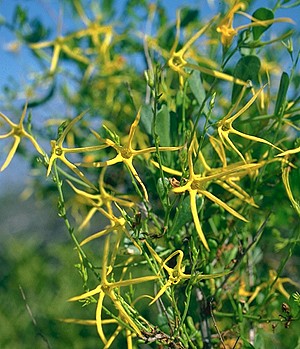
Synonymy
Anthocercis littorea Labill., Nov. Holl. Pl. 2: 19, t. 158 (1806)
T: `Habitat in terrâ Van-Leuwin' (south-western W.A.), Labillardière s.n.; syn: FI, G, P.
A. glabella Miers, Ann. Mag. Nat. Hist., ser. 2, 11: 373 (1853).
T: Fremantle, W.A., Gilbert s.n.; n.v.
Description
Erect, rarely sprawling, shrub to 3 m, much-branched from base, the branches and leaves glabrous; seedlings with scattered prickles on stem.
Leaves obovate to narrowly obovate, sometimes spathulate, sessile or almost so, 18–65 mm long, 4–31 mm wide, usually thick and fleshy, entire, or juvenile leaves dentate.
Inflorescence raceme-like, leafy; pedicels 2.5–7.5 mm long. Calyx 4–7.5 mm long. Corolla 14–32 mm long, yellow or pale yellow, the striations brown, purple-brown or maroon; lobes linear, 10– 25 mm long, 2–4 mm wide. Stamens 3–8 mm long.
Capsule narrowly ovoid to narrowly ovoid-ellipsoid, acute to acuminate or apiculate, 9–19 mm long. Seeds 1.5–1.9 mm long.
Distribution and ecology
Endemic in south-western W.A. along the southern and western coasts, extending north to Geraldton.
Grows in calcareous sand; a colonising species common after fire or disturbance.
Common name
Yellow Tailflower
Notes
Easily confused with A. ilicifolia Hook. with which it is sympatric on the west coast; distinguished by the much-branched habit, leafy inflorescence, and corolla size and shape.
Fruit are often malformed due to galling. This is caused by a recently described gall midge, Asphondylia anthocercidis Kolesik.
Reference: Kolesik, P. Whittemore, R. & Stace, H.M. (1997). Asphondylia anthocercidis, a new species of Cecidomyiidae (Diptera) inducing fruit galls on Anthocercis littorea (Solanaceae) in
Suspected of poisoning stock; rarely known to have poisoned children.
Phylogenetic studies by Garcia & Olmstead (2003) on the Tribe Anthocercideae using two chloroplast DNA regions included this species. The studies indicated that Anthocercis is monophyletic.
Reference: V.F.Garcia & R.G.Olmstead (2003). Phylogenetics of Tribe Anthocercideaea (Solanaceae) based on ndhF and trnL/F sequence data. Systematic Botany 28: 609-615.
Selected specimens
W.A.: Geraldton, R. Coveny 3041 (NSW, PERTH); c. 3 km NE of Esperance, L. Haegi 1245 (AD, BRI, CANB, F, PERTH); c. 13 km W of Denmark, 13 Sept. 1963, J.H. Willis (MEL).
Derivation of epithet
From the Latin, littoreus, pertaining to the sea-shore, a reference to the usual habitat of this species
Images and information on web
Close-up images of the flowers and leaves of A. littorea can be seen on
- the Solanaceae page of the Delta-intkey site at http://delta-intkey.com/angio/images/antoc021.jpg and at http://delta-intkey.com/angio/images/antoc022.jpg
- the Florabase site at florabase.dec.wa.gov.au/
browse/photo/6949 - the Australian Plants Society at asgap.org.au/a-lit.html
Pharmacology: A discussion of the tropane alkaloids which occur in Anthocercis and other Anthocercideae can be found in Griffith & Lin (2000). A. littorea has a similar profile to A. ilicifolia.
Ref: W.J. Griffin & G.D. Lin (2000). Chemotaxonomy and geographical distribution of tropane alkaloids. Phytochemistry 53: 627–628.
References to the possible toxic properties of Anthocercis species can be found with a search in the
FDA Poisonous Plant Database
